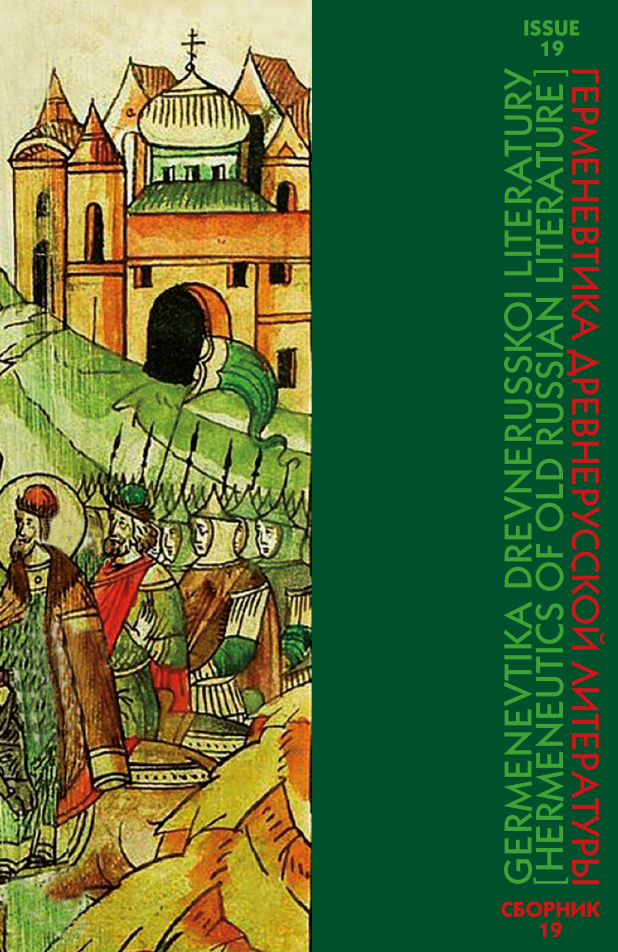Abstract
The article examines the Tale of the Median Place of the 15th century in the edition of the Rumyantsev collection of the 17th century. The Tale is organically integrated into the corpus of texts on oriental subjects from the collection, representing a kind of connecting text between Byzantine-Turkish themes and travel notes (khozhdenie). It can be assumed that the main function of the Tale in the collection was an artistic attempt to describe the shrines of Mecca and Medina in the 15th century which make a kind of transition from the Tale of the Capture of Constantinople by the Turks in 1453, which continued the Byzantine theme (extracts from various chronicles about Constantinople), to works on oriental themes (Triphon Korobeinikov’s Journey to the Holy Places). This is evidenced by the heterogeneity of the artistic construction of text, combining the objectivity of a documentary essay and the subjectivity of personal perception of what was seen, which was characteristic of works of this genre dating back to the 16th century. The poetics of the Tale is a fairly striking example of a combination of expressive and figurative elements and everyday descriptive details in order to give the text an additional figurative tone, which helps to simultaneously present exotic countries and their attractions to the reader in a visual (documentary) and entertaining way.
REFERENCES
1 Bogdanov, A.P., and N.V. Belov. “Khronograf Russkii III redaktsii iz 182 glav. Chast’ 1. Khronograf patriarshego skriptoriia 1680-kh gg.” [“Chronograph Russian 3rd Edition of 182 Chapters. Part 1. Chronograph of the Patriarchal Scriptorium of the 1680s.”]. Slovesnost’ i istoriia. St. Petersburg, Pushkin House RAS Publ., 2021, pp. 73–122. (In Russian)
2 Drevnerusskaia literatura XI–XVII vv.: uchebnoe posobie dlia studentov vuzov [Old Russian Literature of the 11th–17th Centuries: Textbook for University Students], [L.A. Ol’shevskaia et al.], ed. V.I Korovin. Moscow, Vlados Publ., 2003. 448 p. (In Russian)
3 Kirillin, V.M. “Grob Gospoden’ glazami drevnerusskikh palomnikov XII– XVII vv.” [“Holy Sepulchre through the Eyes of Old Russian Pilgrims of the 12th–17th Centuries”]. Germenevtika drevnerusskoi literatury [Hermeneutics of Old Russian Literature]. Issue 21. Ed.-in-chief O.A. Tufanova. Moscow, IWL RAS Publ., 2022, pp. 368–411. https://doi.org/10.22455/HORL.1607-6192-2022-21- 368-411 (In Russian)
4 Luchitskaia, S.I. “‘Zhizn’ Magometa’ Embriko Maintsskogo: legenda i istoriia” [“‘The Life (Vita) of Mohammed’ by Embrico of Mainz: Legend and History]. Ot teksta k real’nosti: (Ne)vozmozhnosti istoricheskikh rekonstruktsii. Sbornik statei [From Text to Reality: (Im)possibilities of Historical Reconstructions. Collection of Articles], O.I. Togoeva, I.N. Danilevsky (eds.). Moscow, IWH RAS Publ., 2012, pp. 25–71. (In Russian)
5 Prokof ’ev, N.I. “Literatura puteshestvii XVI–XVII vv.” [“Travel Literature of the 16th–17th Centuries”]. Zapiski russkikh puteshestvennikov XVI–XVII vv. [Notes of Russian Travelers of the 16th–17th Centuries], [comp., prep. texts and comm. N.I. Prokofiev, L.I. Alekhina; introd. N.I. Prokofiev]. Moscow, Sovetskaia Rossiia Publ., 1988, pp. 5–20. (In Russian)
6 Prokof ’ev, N.I. “‘Khozhdenie’ kak zhanr v drevnerusskoi literature [“‘Journey’ as a Genre in Old Russian Literature”]. Reviakin, A.I., ed. Voprosy russkoi literatury, vol. 288. Moscow, [n. p.], 1968, pp. 3–24. (Scientific notes, V.I. Lenin Moscow Pedagogical Institute). (In Russian)
7 Sobolevskii, A.I. Perevodnaia literatura Moskovskoi Rusi XIV–XVIII vekov: Bibliograficheskie materialy [Translated Literature of Muscovite Rus’ of the 14th–18th Centuries: Bibliographic Materials], [essay] by acad. A.I. Sobolevsky. St. Petersburg, Tipografiia Imperatorskoi Akademii Nauk Publ., 1903. VIII, 460 p. (In Russian)
8 Morris, Ian. Death-ritual and Social Structure in Classical Antiquity. New York, Cambridge University Press, 1992. 264 p. (In English)
9 Reichert, Folker. “Der eiserne Sarg des Propheten.” Grenze und Grenzüberschreitung im Mittelalter Knefelkamp, U., Bosselmann-Cyran, K. (Hrsg.). Berlin, Akad.-Verl., 2007. S. 453–469. (In German)






